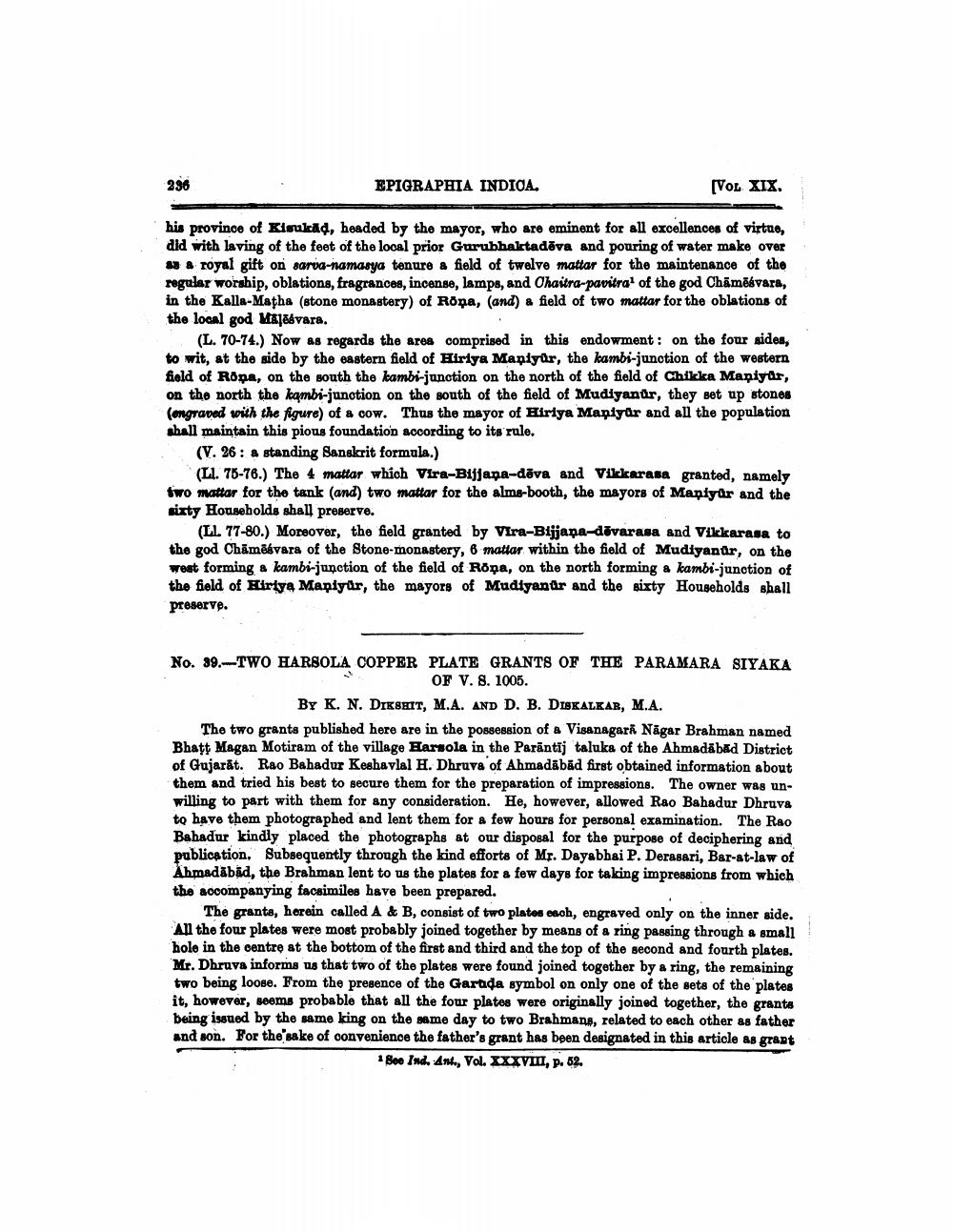________________
236
EPIGRAPHIA INDICA.
[VOL XIX.
his province of Kisukad, headed by the mayor, who are eminent for all excellences of virtue, did with laving of the feet of the local prior Gurubhaktadēva and pouring of water make over as a royal gift on sarva-namasya tenure a field of twelve mattor for the maintenance of the regular worship, oblations, fragrances, incense, lamps, and Chaitra-pavitral of the god Chāmēsvara, in the Kalla-Matha (stone monastery) of Ropa, (and) a field of two mattor for the oblations of the local god Majē vara.
(L. 70-74.) Now as regards the area comprised in this endowment : on the four sides, to wit, at the side by the eastern field of Hiriya Mapiyür, the kambi-junction of the western field of Ropa, on the south the kambi-junction on the north of the field of Chikka Mapiyur, on the north the kambi-junction on the south of the field of Mudiyanür, they set up stones (ongraved with the figure) of & cow. Thus the mayor of Hiriya Mapiyor and all the population shall maintain this pious foundation according to its rule.
(V. 26: a standing Sanskrit formula.)
(LI. 76-76.) The 4 mattar which Vira-Bijjapa-döva and Vilkarasa granted, namely two mattor for the tank (and) two mattor for the alms-booth, the mayors of Maniyar and the sixty Households shall preserve.
(LL. 77-80.) Moreover, the field granted by Vira-Bijjana-dövarasa and Vikkarasa to the god Chāmēsvara of the Stone-monastery, 6 matiar within the field of Mudiyanür, on the weat forming a kambi-junction of the field of Rona, on the north forming a kambi-junction of the field of Hiriya Mapiyar, the mayors of Mudiyantr and the sixty Households shall preserve.
No. 39.-TWO HARSOLA COPPER PLATE GRANTS OF THE PARAMARA SIYAKA
OF V. 8. 1005. BY K. N. DIKSHIT, M.A. AND D. B. DISKALKAR, M.A. The two grants published here are in the possession of a Visanagari Nägar Brahman named Bhatt Magan Motiram of the village Harsola in the Parāntij taluka of the Ahmadabad District of Gujarat. Rao Bahadur Keshavlal H. Dhruva of Ahmadābād first obtained information about them and tried his best to secure them for the preparation of impressions. The owner was unwilling to part with them for any consideration. He, however, allowed Rao Bahadur Dhruva to have them photographed and lent them for a few hours for personal examination. The Rao Bahadur kindly placed the photographs at our disposal for the purpose of deciphering and publication. Subsequently through the kind efforts of Mr. Dayabhai P. Derasari, Bar-at-law of Ahmadābād, the Brahman lent to us the plates for a few days for taking impressions from which the accompanying facsimiles have been prepared.
The grants, herein called A & B, consist of two platos cach, engraved only on the inner side. All the four plates were most probably joined together by means of a ring passing through a small hole in the centre at the bottom of the first and third and the top of the second and fourth plates. Mr. Dhruva informs us that two of the plates were found joined together by a ring, the remaining two being loose. From the presence of the Gartda symbol on only one of the sets of the plates it, however, seems probable that all the four plates were originally joined together, the grants being issued by the same king on the same day to two Brahmans, related to each other as father and son. For the sake of convenience the father's grant has been designated in this article as grant
See Ind. Ant., Vol. XXXVII, p. 62.




